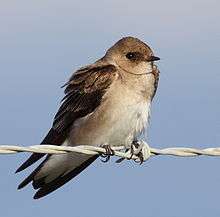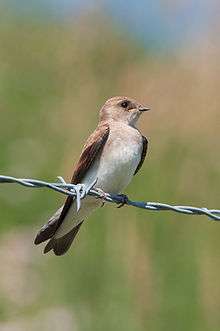Northern rough-winged swallow
| Northern rough-winged swallow | |
|---|---|
 | |
| Adult | |
 | |
| Juvenile | |
| Scientific classification | |
| Kingdom: | Animalia |
| Phylum: | Chordata |
| Class: | Aves |
| Order: | Passeriformes |
| Family: | Hirundinidae |
| Genus: | Stelgidopteryx |
| Species: | S. serripennis |
| Binomial name | |
| Stelgidopteryx serripennis (Audubon, 1838) | |
The northern rough-winged swallow (Stelgidopteryx serripennis) is a small, migratory swallow. It is very similar to the southern rough-winged swallow, Stelgidopteryx ruficollis.
Taxonomy and etymology
The genus name, Stelgidopteryx, is from Ancient Greek and means "scraper wing" and the species name, serripennis, is derived from Latin and means "saw feather".[2] In the common name, "rough-winged" refers to the serrated edge feathers on the wing of this bird; this feature would only be apparent when holding this bird.[3][4]
Subspecies
Six subspecies of the northern rough-winged swallow are currently recognized.
- S. s. serripennis is the nominate subspecies and can be found to occur in southern Alaska and Canada to the southern United States. They are found to usually winter in southern Florida and from southwestern Mexico to Panama. It was described by Audubon in 1838.[5][1]
- S. s. psammochroa was described by Ludlow Griscom in 1929. It breeds in the southwestern US and winters from central Mexico to Panama. It can be differentiated from the nominate race by being paler, especially on the crown and rump.[6][5]
- S. s. fulvipennis is a resident of central Mexico to Costa Rica. It was the first subspecies to be differentiated from the nominate race, serripennis, and was differentiated by Philip Sclater in 1860. It is darker above; the crown darker more so.[5] The shafts of the under tail coverts, the feathers under the tail, covering the base, have been observed to be darker near the end. The throat of these swallows seem to be slightly buff, unlike most of the other subspecies.[6]
- S. s. stuarti, a very dark variant of the northern rough-winged swallow, was described by Pierce Brodkorb in 1942. It is resident to the southern Mexico lowlands and south to eastern Guatemala.[5] Like the race fulvipennis, it has a slightly buff throat. The under tail coverts also have black tips.[6]
- S. s. ridgwayi, described by Edward Nelson in 1901, is a subspecies resident to the northern Yucatán Peninsula. It is larger than the nominate race with a whitish spot above its lores and has blackish tips on the longest of its under tail coverts.[5] In addition, it is darker above and has paler anterior underparts.[6]
- S. s. burleighi, described by Allan Robert Phillips in 1986, is the most recent, widely accepted subspecies. It is resident to Belize and Guatemala, and is the darkest of the subspecies.[5]
It has been proposed that another race be recognized, aphracta, but this is debated. This race is apparently described as being darker above with a greyer throat compared to serripennis. It has been described to occur in the western Great Basin region, in the United States.
Description
Adults are 13–15 cm (5.1–5.9 in) in length, brown above with white underparts, a small bill, and a forked tail. Their throat is a white with a brownish-grey wash, and below the throat are its white underparts. The adults have a wingspan of 27–30 cm (11–12 in) and a weight of 10–18 g (0.35–0.63 oz).[2] The males' under tail coverts are longer and broader than that of the females.[7] The males also have hooked barbs on the outer web of their outer primary wings. The barbs on the females are shorter and straighter than that of the males. Juveniles can be distinguished from adults by their reddish-brown wing-bars.[3][4][8][5][6]
They are similar in appearance to the bank swallow, but have a dusky throat and breast. They are closely related and very similar to the southern rough-winged swallow, Stelgidopteryx ruficollis, but that species has a more contrasting rump, and the ranges do not quite overlap.
Call
The call of this swallow is described as a short, harsh zeep.[9] It has also been described as a rough, low bzzt. It is often doubled.[10] This call is similar to the call of the bank swallow.[11]
Distribution
The northern rough-winged swallow is native to Bahamas, Belize, Canada, Cayman Islands, Costa Rica, Cuba, El Salvador, Guatemala, Haiti, Honduras, Jamaica, Mexico, Nicaragua, Panama, Puerto Rico, Saint Pierre and Miquelon, Turks and Caicos Islands, and the United States. They are vagrant to Aruba, Barbados, Bonaire, Sint Eustatius and Saba, Curaçao, Dominican Republic, Guadeloupe, and Sint Maarten.[1] The populations in the US and Canada have been found to winter in the southern-most US and further south. While this is true, the populations in Mexico and further south seem to be non-migratory, although local post-breeding movements do occur. This swallow has been found to occur as high as 2,500 m (8,200 ft) in Costa Rica.[1][5]
Behaviour
_(13806434385).jpg)
Nesting and Breeding
The northern rough-winged swallow usually nest near streams, lakes and river banks across North America. They nest in cavities near water, usually a burrow in dirt; they do not usually form colonies.[9] While they do prefer riverbanks, they prefer a drier site than the bank swallow that it is often confused with.[10] The burrows they nest in are usually .3–1.8 m (0.98–5.91 ft) deep. The nests at the end of the burrows are usually made with twigs, weeds, bark, and are lined with fine grass. Some of these swallows have been recorded to use small drainage pipes or other artificial cavities as nest sites.[12] They usually nest solitarily or in small groups. They seem to frequently nest on the edge of bank swallow colonies.
The normal clutch is four to eight eggs, incubated by the female for about 13 days, with about another 20 to fledging.[9][11] The male rarely enters the nest while the female is incubating, instead choosing to perch by the nest. The female incubates in up to 30 minute periods and usually goes to feed for a period shorter than 30 minutes. The eggs are white and are usually 4–8 cm (1.6–3.1 in) long.[2] This swallow only has one brood per year.[12] It has been observed that the clutch size decreases with decreasing latitude.[5]
Migration habits
The northern rough-winged swallow migrates to the Gulf Coast of the United States and south to Central America for winter.[13] They have also been recorded to winter in the Caribbean.[5]
When the breeding season is finished, they usually form large flocks and roost together in marshes and similar environments. Sometimes, in perverse weather conditions, several of these swallows can be seen to share a burrow.[6]
Diet
When foraging, their flight paths are low and direct. They fly with slow, deep wingbeats interspersed with periods of gliding. It usually feeds over water and occasionally over land. They are insectivores, feeding almost exclusively on flying insects.[6][9][13] Although this is true, there is a report of some feeding on cracked corn.[5] To drink, they skim the surface of the water with their wing and then drink on their wing.[9][4]
Status
The northern rough-winged swallow is classified as least concern by the IUCN. Although its population is declining, it is not declining fast enough nor is its range small enough to justify a classification of vulnerable.[1] In addition, this species is estimated to be composed of about 15 million individual birds, so it is not vulnerable under the population size criterion. This swallow has been found to adapt well to humans and sometimes nests in artificial cavities created by them.[2][5][6][12]
References
- 1 2 3 4 5 BirdLife International (2012). "Stelgidopteryx serripennis". IUCN Red List of Threatened Species. Version 2013.2. International Union for Conservation of Nature. Retrieved 26 November 2013.
- 1 2 3 4 "Northern Rough-winged Swallow, Life History, All About Birds - Cornell Lab of Ornithology". Retrieved November 6, 2016.
- 1 2 "Northern Rough-winged Swallow". Retrieved November 6, 2016.
- 1 2 3 "Northern Rough-winged Swallow - Whatbird.com". Retrieved November 27, 2016.
- 1 2 3 4 5 6 7 8 9 10 11 12 Turner, Angela; de Juana, Eduardo (2013). del Hoyo, Josep; Elliott, Andrew; Sargatal, Jordi; Christie, David A.; de Juana, Eduardo, eds. "Mangrove Swallow (Tachycineta albilinea)". Handbook of the Birds of the World Alive. Barcelona: Lynx Edicions. Retrieved 20 November 2016. (Subscription required (help)).
- 1 2 3 4 5 6 7 8 Turner, Angela K; Rose, Chris (1989). Swallows & Martins: An Identification Guide and Handbook. Boston: Houghton Mifflin. ISBN 0-395-51174-7. p94–96
- ↑ Bent, Arthur Cleveland. Smithsonian Institution United States National Museum Bulletin 179. Smithsonian Institution United States National Museum Bulletin. 179. pp. 424–423. Retrieved November 7, 2016.
- ↑ "Northern Rough-winged Swallow, Identification, All About Birds - Cornell Lab of Ornithology". Retrieved November 6, 2016.
- 1 2 3 4 5 "Northern Rough-winged Swallow - Bird Watcher's Digest". Retrieved November 6, 2016.
- 1 2 "Northern Rough-winged Swallow "Stelgidopteryx serripennis" | Boreal Songbird Initiative". Retrieved November 27, 2016.
- 1 2 "Northern Rough-Winged Swallow". Retrieved November 19, 2016.
- 1 2 3 "Northern Rough-winged Swallow | Audubon Field Guide". Retrieved November 19, 2016.
- 1 2 "Northern Rough-winged Swallow - South Dakota Birds and Birding". Retrieved November 7, 2016.
External links
| Wikimedia Commons has media related to Northern rough-winged swallow. |
| Wikispecies has information related to: Stelgidopteryx serripennis |
- Northern rough-winged swallow - Stelgidopteryx serripennis - USGS Patuxent Bird Identification InfoCenter
- Northern Rough-winged Swallow Species Account - Cornell Lab of Ornithology
- "Northern Rough-winged Swallow media". Internet Bird Collection.
- Northern Rough-winged Swallow photo gallery at VIREO (Drexel University)
- Interactive range map of Stelgidopteryx serripennis at IUCN Red List maps
